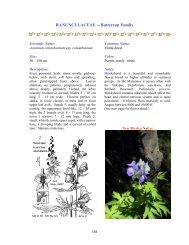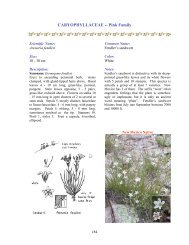BERBERIDACEAE -- Barberry Family - New Mexico Flores
BERBERIDACEAE -- Barberry Family - New Mexico Flores
BERBERIDACEAE -- Barberry Family - New Mexico Flores
Create successful ePaper yourself
Turn your PDF publications into a flip-book with our unique Google optimized e-Paper software.
CAPRIFOLIACEAE -- Honeysuckle <strong>Family</strong><br />
Scientific Name:<br />
Sambucus racemosa var. microbotrys<br />
Size:<br />
100 - 200 cm<br />
Description:<br />
Synonym: Sambucus microbotrys.<br />
Perennial shrub, twigs and young branches with<br />
conspicuous pith. Branches and leaves<br />
glabrous. Leaves opposite, odd-pinnately<br />
compound, leaflets 5 - 7, ovate to ovatelanceolate,<br />
6 - 12 cm long, with pointed tips and<br />
rounded bases, edges coarsely toothed. Flowers<br />
perfect, in dense ovoid or pyramidal clusters 4 -<br />
7 cm wide, at stem ends. Sepals 3 - 5, minute.<br />
Corolla round, flat, with 3 - 5 equal lobes, these<br />
much longer than the tube. Stamens 5. Fruit<br />
bright red, 4 - 5 mm in diameter.<br />
182<br />
Common Name:<br />
Red elderberry<br />
Color:<br />
White to cream<br />
Notes:<br />
Elderberry bushes vary in size from a single<br />
twig to large shrubs taller and wider than a<br />
person. The berries of several varieties of elder<br />
berry are eaten by birds and bears, and wines<br />
and jellies are made by enterprising humans.<br />
Red elderberry, however, is considered toxic,<br />
particularly leaves, stems, and roots. It blooms<br />
in June and early July between 8000 and 11000<br />
ft.<br />
<strong>New</strong> <strong>Mexico</strong> Native




